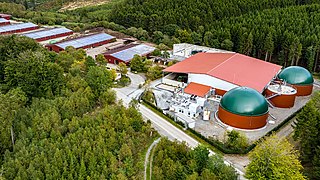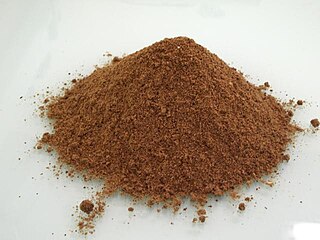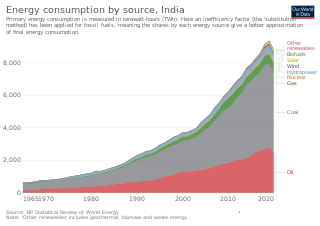
Biogas is a mixture of gases, primarily consisting of methane, carbon dioxide and hydrogen sulphide, produced from raw materials such as agricultural waste, manure, municipal waste, plant material, sewage, green waste and food waste. It is a renewable energy source.

Cargill, Incorporated, is a privately held American global food corporation based in Minnetonka, Minnesota, and incorporated in Wilmington, Delaware. Founded in 1865, it is the largest privately held corporation in the United States in terms of revenue. If it were a public company, it would rank, as of 2015, number 15 on the Fortune 500, behind McKesson and ahead of AT&T. Cargill has frequently been the subject of criticism related to the environment, human rights, finance, and other ethical considerations.

Koninklijke DSM N.V., is a Dutch multinational corporation active in the fields of health, nutrition and materials. Headquartered in Heerlen, at the end of 2017 DSM employed 21,054 people in approximately 50 countries and posted net sales of €8.632 billion in 2018 and €9.204 billion in 2021.
Methanotrophs are prokaryotes that metabolize methane as their source of carbon and chemical energy. They are bacteria or archaea, can grow aerobically or anaerobically, and require single-carbon compounds to survive.

Anaerobic digestion is a sequence of processes by which microorganisms break down biodegradable material in the absence of oxygen. The process is used for industrial or domestic purposes to manage waste or to produce fuels. Much of the fermentation used industrially to produce food and drink products, as well as home fermentation, uses anaerobic digestion.

A biorefinery is a refinery that converts biomass to energy and other beneficial byproducts. The International Energy Agency Bioenergy Task 42 defined biorefining as "the sustainable processing of biomass into a spectrum of bio-based products and bioenergy ". As refineries, biorefineries can provide multiple chemicals by fractioning an initial raw material (biomass) into multiple intermediates that can be further converted into value-added products. Each refining phase is also referred to as a "cascading phase". The use of biomass as feedstock can provide a benefit by reducing the impacts on the environment, as lower pollutants emissions and reduction in the emissions of hazard products. In addition, biorefineries are intended to achieve the following goals:
- Supply the current fuels and chemical building blocks
- Supply new building blocks for the production of novel materials with disruptive characteristics
- Creation of new jobs, including rural areas
- Valorization of waste
- Achieve the ultimate goal of reducing GHG emissions

Fish meal is a commercial product made from whole wild-caught fish, bycatch and fish by-products to feed farm animals, e.g., pigs, poultry, and farmed fish. Because it is calorically dense and cheap to produce, fishmeal has played a critical role in the growth of factory farms and the number of farm animals it is possible to breed and feed.

Methylococcus capsulatus is an obligately methanotrophic gram-negative, non-motile coccoid bacterium. M. capsulatus are thermotolerant; their cells are encapsulated and tend to have a diplococcoid shape. In addition to methane, M. capsulatus is able to oxidize some organic hydrogen containing compounds such as methanol. It has been used commercially to produce animal feed from natural gas.
In animal husbandry, feed conversion ratio (FCR) or feed conversion rate is a ratio or rate measuring of the efficiency with which the bodies of livestock convert animal feed into the desired output. For dairy cows, for example, the output is milk, whereas in animals raised for meat the output is the flesh, that is, the body mass gained by the animal, represented either in the final mass of the animal or the mass of the dressed output. FCR is the mass of the input divided by the output. In some sectors, feed efficiency, which is the output divided by the input, is used. These concepts are also closely related to efficiency of conversion of ingested foods (ECI).

Fermentation is a metabolic process that produces chemical changes in organic substrates through the action of enzymes. In biochemistry, it is narrowly defined as the extraction of energy from carbohydrates in the absence of oxygen. In food production, it may more broadly refer to any process in which the activity of microorganisms brings about a desirable change to a foodstuff or beverage. The science of fermentation is known as zymology.

Salt End or Saltend is a hamlet in the East Riding of Yorkshire, England, in an area known as Holderness. It is situated on the north bank of the Humber Estuary just outside the Hull eastern boundary on the A1033 road. It forms part of the civil parish of Preston.

Since 2013, total primary energy consumption in India has been the third highest in the world after China and United States. India is the second-top coal consumer in the year 2017 after China. India ranks third in oil consumption with 22.1 crore tons in 2017 after United States and China. India is net energy importer to meet nearly 47% of its total primary energy in 2019.

Animal feed is food given to domestic animals, especially livestock, in the course of animal husbandry. There are two basic types: fodder and forage. Used alone, the word feed more often refers to fodder. Animal feed is an important input to animal agriculture, and is frequently the main cost of the raising or keeping of animals. Farms typically try to reduce cost for this food, by growing their own, grazing animals, or supplementing expensive feeds with substitutes, such as food waste like spent grain from beer brewing.
TerraVia Holdings, Inc. was a publicly held biotechnology company in the United States. TerraVia used proprietary technology to transform a range of low-cost plant-based sugars into high-value oils and whole algae ingredients. TerraVia supplied a variety of sustainable algae-based food ingredients to a number of brands, which included Hormel Food Corporation, Utz Quality Foods Inc., and Enjoy Life Foods. TerraVia also sold its own culinary algae oil under the Thrive Algae Oil brand.

The aquaculture of salmonids is the farming and harvesting of salmonids under controlled conditions for both commercial and recreational purposes. Salmonids, along with carp, and tilapia are the three most important fish species in aquaculture. The most commonly commercially farmed salmonid is the Atlantic salmon. In the U.S. Chinook salmon and rainbow trout are the most commonly farmed salmonids for recreational and subsistence fishing through the National Fish Hatchery System. In Europe, brown trout are the most commonly reared fish for recreational restocking. Commonly farmed nonsalmonid fish groups include tilapia, catfish, sea bass, and bream.

Manufactured feeds are an important part of modern commercial aquaculture, providing the balanced nutrition needed by farmed fish. The feeds, in the form of granules or pellets, provide the nutrition in a stable and concentrated form, enabling the fish to feed efficiently and grow to their full potential.

Corbion N.V., formerly Centrale Suiker Maatschappij (CSM) N.V., is a Dutch food and biochemicals company headquartered in Amsterdam, Netherlands. It produces bioingredient-based foods, chemicals derived from organic acids, and lactic acid based solutions for the food, chemical and pharmaceutical industries. The company was founded on August 21, 1919.
Power-to-gas is a technology that uses electric power to produce a gaseous fuel. When using surplus power from wind generation, the concept is sometimes called windgas.
Food security refers to ensuring adequate food supply to people, especially those who are deprived of basic nutrition. Food security has been a major concern in India. According to UN-India, there are nearly 195 million undernourished people in India, which is a quarter of the world's hunger burden. Also, roughly 43% of children in India are chronically undernourished. India ranks 68 out of 113 major countries in terms of food security index 2022. Though the available nutritional standard is 100% of the requirement, India lags far behind in terms of quality protein intake at 20% which needs to be tackled by making available protein-rich food products such as soybeans, lentils, meat, eggs, dairy, etc. at affordable prices. The Human Rights Measurement Initiative finds that India is doing 56.8% of what should be possible at its level of income for the right to food.
AgriProtein is a British agricultural and biotechnology company that uses insects to convert food waste into sustainable products including: an alternative protein for use in livestock and aquaculture feed, a natural oil for use in animal feed, and an organic soil enhancer. The company was founded in 2008 in South Africa. AgriProtein is a subsidiary of the Insect Technology Group.













